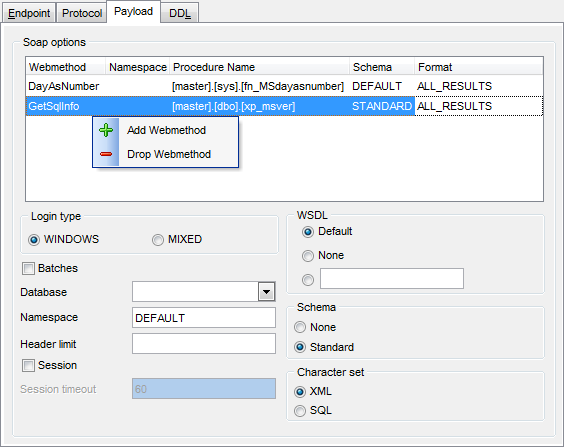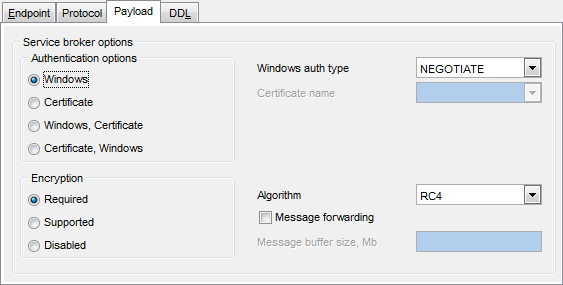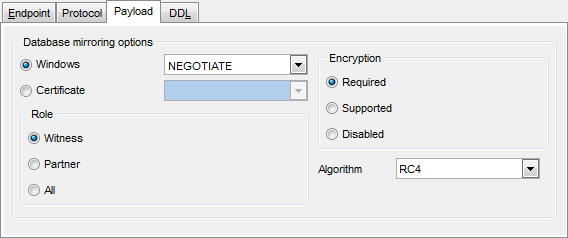Online Documentation for SQL Manager for SQL server
Setting payload options
The Payload tab allows you to define the payload that is supported on the endpoint.

Soap options
This group is available if ![]() HTTP is selected as the Protocol type and
HTTP is selected as the Protocol type and ![]() Soap is specified as the Payload type at the Endpoint tab of the editor.
Soap is specified as the Payload type at the Endpoint tab of the editor.
The upper area of the group displays the webmethods (the methods for which HTTP SOAP requests can be sent to the endpoint) as a grid with the following columns: Webmethod, Namespace, Procedure name, Schema, Format.
Right-click an item within the list to call the context menu allowing you to ![]() add a new webmethod or
add a new webmethod or ![]() drop the selected one.
drop the selected one.
Login type
Specify the SQL Server authentication mode for the endpoint:
![]() WINDOWS
WINDOWS
This option allows only Windows authentication to be used to authenticate endpoint users.
![]() MIXED
MIXED
This option allows either SQL Server authentication or Windows authentication to be used to authenticate endpoint users.
![]() Batches
Batches
This option specifies whether special SQL requests are supported on the endpoint. If checked, SOAP requests for queries that use the sqlbatch method can be sent to this endpoint.
Database
Use the drop-down list to select the database in the context of which the requested operation will be executed.
Namespace
Specify the namespace for the endpoint.
Header limit
This value specifies the maximum size, of the header section in the SOAP envelope (in bytes).
![]() Session
Session
This option specifies whether the instance of SQL Server allows sessions support. If checked, SQL Server allows sessions support, whereby multiple SOAP request/response message pairs can be identified as part of a single SOAP session.
Session timeout
Specify time that is available before a SOAP session expires at the server when no further requests are received (in seconds).
WSDL
This group indicates whether WSDL document generation is supported for this endpoint: ![]() None,
None, ![]() Default (a default WSDL response is generated and returned for WSDL queries submitted to the endpoint), or specify stored procedure by name that will return a modified WSDL document.
Default (a default WSDL response is generated and returned for WSDL queries submitted to the endpoint), or specify stored procedure by name that will return a modified WSDL document.
Schema
This group specifies whether an XSD schema is returned by the endpoint when SOAP results are sent.
![]() NONE
NONE
This option omits inline schema from SOAP responses.
![]() STANDARD
STANDARD
This option includes inline schema in endpoint responses.
Character set
This group defines the character set behavior: ![]() XML (by default), or
XML (by default), or ![]() SQL (the characters that are not valid as character references are encoded, and then returned in the result).
SQL (the characters that are not valid as character references are encoded, and then returned in the result).

Service Broker options
This group is available if ![]() TCP is selected as the Protocol type and
TCP is selected as the Protocol type and ![]() Service broker is specified as the Payload type at the Endpoint tab of the editor.
Service broker is specified as the Payload type at the Endpoint tab of the editor.
Authentication options
![]() Windows
Windows
Specifies that the endpoint is to connect using Windows Authentication protocol to authenticate the endpoints. In this case you should also select an authorization method (NTLM or KERBEROS) to be used as the authentication protocol, or NEGOTIATE that causes the endpoint to use the Windows negotiation protocol to choose either NTLM or Kerberos.
![]() Certificate
Certificate
Specifies that the endpoint is to authenticate the connection using a certificate (you should select one from the drop-down list) to establish identity for authorization.
![]() Windows, Certificate
Windows, Certificate
Specifies that the endpoint is to try to connect by using Windows Authentication and, if that attempt fails, to then try using the specified certificate.
![]() Certificate, Windows
Certificate, Windows
Specifies that the endpoint is to try to connect by using the specified certificate and, if that attempt fails, to then try using Windows Authentication.
Windows auth type
Use the drop-down list to select an authorization method (NTLM or KERBEROS) to be used as the authentication protocol, or NEGOTIATE that causes the endpoint to use the Windows negotiation protocol to choose either NTLM or Kerberos.
Certificate name
Use the drop-down list to select a certificate to be used to authenticate the connection.
Encryption
This group specifies whether encryption is used in the process.
![]() Required
Required
Specifies that connections to this endpoint must use encryption. Therefore, to connect to this endpoint, another endpoint must have ENCRYPTION set to either SUPPORTED or REQUIRED.
![]() Supported
Supported
Specifies that the data is encrypted only if the opposite endpoint specifies either SUPPORTED or REQUIRED.
![]() Disabled
Disabled
Specifies that data sent over a connection is not encrypted.
Algorithm
Specify the form of encryption used by the endpoint:
RC4 (specifies that the endpoint must use the RC4 algorithm)
AES (specifies that the endpoint must use the AES algorithm)
AES RC4 (specifies that the two endpoints will negotiate for an encryption algorithm with this endpoint giving preference to the AES algorithm)
RC4 AES (specifies that the two endpoints will negotiate for an encryption algorithm with this endpoint giving preference to the RC4 algorithm)
![]() Message forwarding
Message forwarding
This option determines whether messages received by this endpoint that are for services located elsewhere will be forwarded.
Message buffer size, Mb
Use the spinner control to specify the maximum amount of storage (in megabytes) to allocate for the endpoint to use when storing messages that are to be forwarded (if Message forwarding is selected).

Database mirroring options
This group is available if ![]() TCP is selected as the Protocol type and
TCP is selected as the Protocol type and ![]() Database mirroring is specified as the Payload type at the Endpoint tab of the editor.
Database mirroring is specified as the Payload type at the Endpoint tab of the editor.
Specify the TCP/IP authentication requirements for connections for this endpoint:
![]() Windows
Windows
Specifies that the endpoint is to connect using Windows Authentication protocol to authenticate the endpoints. In this case you should also select an authorization method (NTLM or KERBEROS) to be used as the authentication protocol, or NEGOTIATE that causes the endpoint to use the Windows negotiation protocol to choose either NTLM or Kerberos.
![]() Certificate
Certificate
Specifies that the endpoint is to authenticate the connection using a certificate (you should select one from the drop-down list) to establish identity for authorization.
Encryption
This group specifies whether encryption is used in the process.
These options are common for Service broker and Database mirroring payload types. For details see Service Broker options.
Algorithm
Specifies the form of encryption used by the endpoint.
This option is common for Service broker and Database mirroring payload types. For details see Service Broker options.
Role
This group specifies the database mirroring role or roles that the endpoint supports.
![]() Witness
Witness
Enables the endpoint to perform in the role of a witness in the mirroring process.
![]() Partner
Partner
Enables the endpoint to perform in the role of a partner in the mirroring process.
![]() All
All
Enables the endpoint to perform in the role of both a witness and a partner in the mirroring process.



































































